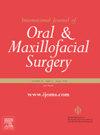碳酸盐磷灰石上颌窦底增强术中形态学变化的回顾性三维图像分析。
IF 2.7
3区 医学
Q2 DENTISTRY, ORAL SURGERY & MEDICINE
International journal of oral and maxillofacial surgery
Pub Date : 2025-06-25
DOI:10.1016/j.ijom.2025.06.015
引用次数: 0
摘要
本回顾性研究的目的是评估两期上颌窦底增强术(MSFA)中碳酸盐磷灰石(CO3Ap)的三维形态稳定性。分析了26例患者的30例MSFA手术中移植物的形态学变化;15例以CO3Ap为接枝材料,15例以β-磷酸三钙(β-TCP)为对照。利用填充后立即和随访(约4个月后)获得的锥束计算机断层扫描数据计算体积比(CVR)和移植区域上表面(GAUS)的变化。作为影响移植物体积的潜在混杂因素,测量了窦底宽度和外侧和内侧窦壁之间的角度。CO3Ap组CVR和GAUS显著低于β-TCP组(CVR: 95.6%±6.7% vs 81.4%±16.5%,P = 0.008;GAUS: 92.4%±6.9% vs 79.3%±13.1%,P = 0.009)。CO3Ap的体积减少4.4%±6.7%,β-TCP的体积减少18.6%±16.5%。调整变量后,材料类型显著影响CVR和GAUS。CO3Ap似乎有望在两阶段MSFA期间保持体积。本文章由计算机程序翻译,如有差异,请以英文原文为准。
Retrospective three-dimensional image analysis of morphological changes in maxillary sinus floor augmentation with carbonate apatite
The aim of this retrospective study was to evaluate the three-dimensional morphological stability of carbonate apatite (CO3Ap) during two-stage maxillary sinus floor augmentation (MSFA). Thirty MSFA procedures in 26 patients were analysed for morphological changes in the grafted materials; CO3Ap was used as the grafting material in 15 cases and β-tricalcium phosphate (β-TCP) in the other 15 (controls). Changes in the volume ratio (CVR) and the upper surface of the regions grafted (GAUS) were calculated using cone beam computed tomography data obtained immediately after filling and at follow-up (approximately 4 months later). The width of the sinus floor and angle between the lateral and medial sinus walls were measured as potential confounders affecting the volume of the grafted materials. CVR and GAUS were significantly lower in the CO3Ap group than in the β-TCP group (CVR: 95.6% ± 6.7% vs 81.4% ± 16.5%, respectively, P = 0.008; GAUS: 92.4% ± 6.9% vs 79.3% ± 13.1%, respectively, P = 0.009). The volume of CO3Ap decreased by 4.4% ± 6.7%, whereas that of β-TCP decreased by 18.6% ± 16.5%. The type of material significantly influenced CVR and GAUS after adjusting for variables. CO3Ap appears promising for maintaining volume during two-stage MSFA.
求助全文
通过发布文献求助,成功后即可免费获取论文全文。
去求助
来源期刊
CiteScore
5.10
自引率
4.20%
发文量
318
审稿时长
78 days
期刊介绍:
The International Journal of Oral & Maxillofacial Surgery is one of the leading journals in oral and maxillofacial surgery in the world. The Journal publishes papers of the highest scientific merit and widest possible scope on work in oral and maxillofacial surgery and supporting specialties.
The Journal is divided into sections, ensuring every aspect of oral and maxillofacial surgery is covered fully through a range of invited review articles, leading clinical and research articles, technical notes, abstracts, case reports and others. The sections include:
• Congenital and craniofacial deformities
• Orthognathic Surgery/Aesthetic facial surgery
• Trauma
• TMJ disorders
• Head and neck oncology
• Reconstructive surgery
• Implantology/Dentoalveolar surgery
• Clinical Pathology
• Oral Medicine
• Research and emerging technologies.

 求助内容:
求助内容: 应助结果提醒方式:
应助结果提醒方式:


